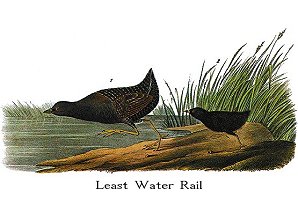
| Family XXXIII. RALLINAE. RAILS. GENUS III. ORTYGOMETRA, Leach. CRAKE-GALLINULE. |
Next >> |

Family |
LEAST WATER RAIL. [Black Rail.] |
| Genus | ORTYGOMETRA JAMAICENSIS, Briss. [Laterallus jamaicensis.] |
My knowledge of this pretty little species is altogether derived from TITIAN PEALE, Esq., of Philadelphia, by whom, in October, 1836, I was favoured
with the following letter:--
"I herewith send you the 'Little Rail' of which we were speaking yesterday,
and the letter of Dr. ROWAN which relates to it. The young died soon after I
received them, but the old one lived with me until the 26th of July (four days
after its capture), evincing considerable anxiety for the young, as long as they
lived. Both young and old partook sparingly of Indian meal and water, or bread
and water, and soon became quite at home, and probably might have been
domesticated, had they been properly accommodated.
"The most remarkable part of the history of this individual is, that after
its death we should have discovered on dissection that it was a male, rendering
it singularly curious that he should have suffered himself to be captured by
hand while in defence of the young brood.
"There is now in the Museum a specimen of this species, which has been in
the collection for about thirty years, said to have been caught in the vicinity
of the city. It stands labelled 'Little Rail, Rallus minutus, Turton's Linn;'
but the authenticity of the specimen has always been disputed by BONAPARTE, and
others, because none else had been found; and the author just named expressed a
belief that it was an immature specimen of Rallus (Crex) Porzana of Europe.
"I regret that I should have mislaid the measurements of the specimen when
recent, if any were taken, and cannot lay my hands on them, or any thing more
than the above notes. Respectfully yours, &c.
TITIAN R. PEALE."
Inclosed in Mr.PEALE's letter was the following note from Dr. ROWAN "to the
Messrs. PEALES."
"On Saturday last I wrote to you of the Rail-bird breeding near this place.
I then described one that I caught last summer, which was unlike the Rail in the
fall season, and I presumed that all in the wet ground were the same, but this
day my men mowing around the pond started up two of the usual kind. The hen
flew a few rods, and then flew back to her young in an instant, when they caught
her, together with her four young, which I herewith send you. Many more can be
caught. I have seen them in our meadow every month of the year, but they never
make a great noise except when very fat on the wild oat's seed. From the above
you will conclude that they do not migrate to the south, but breed here.
Respectfully,
THOMAS ROWAN."
RALLUS JAMAICENSIS, Briss. Suppl., p. 140.
LEAST WATER RAIL, Rallus jamaicensis, Aud. Orn. Biog., vol. iv. P. 359.
Male, 6, wing, 3 7/8.
From Louisiana to New Jersey, in fresh-water meadows and marshes, difficult
of access. Migratory.
Adult Male.
Bill shorter than the head, rather stout, compressed, tapering. Upper
mandible with the dorsal line nearly straight, being slightly convex toward the
end, the ridge narrow and convex in its whole length, the sides convex towards
the end, the edges sharp, the tip rather acute. Nasal groove extending to a
little beyond the middle of the bill; nostrils, linear, lateral, submedial,
pervious. Lower mandible with the angle long and narrow, the sides erect, the
dorsal line sloping upwards, the edges a little inflected, the tip narrowed, the
gap-line straight.
Head rather small, oblong, compressed. Neck shortish. Body compact,
deeper than broad. Feet of moderate length, rather slender; tibia bare a short
way above the joint; tarsus of ordinary length, compressed, anteriorly covered
with broad scutella, posteriorly with smaller, and on the sides reticulated.
Hind toe small and very slender; middle toe longest, and longer than the tarsus;
inner toe considerably shorter than the outer; toes free, with numerous scutella
above. Claws of moderate length, compressed, slightly arched, acute.
Plumage blended, slightly glossy above. Wings short and broad, tapering,
rounded, the first and second nearly equal and longest. Tail very short, much
rounded, of twelve feeble rounded feathers; the upper and lower tail-coverts
nearly as long as the tail-feathers.
Bill black. Iris red. Feet bright yellowish-green, claws dusky. The head
and all the lower parts are very dark purplish-grey, on the upper part of the
head approaching to black, on the fore part of the neck faintly undulated with
paler, on the sides and hind parts barred with greyish-white; the lower
wing-coverts barred with grey and white; the lower tail-coverts of the latter
colour. The hind neck and fore part of the back dark chestnut; the rest of the
back and tail-coverts greyish-black, transversely barred with white.
Wing-coverts and inner secondaries reddish-brown, with white spots; the other
quills more dusky. The tail-feathers also reddish-brown, barred with dusky and
marked with white spots.
Length to end of tail 6 inches; wing from flexure 3 7/8; tail 1 1/16; bill
along the ridge 1/2, along the edge of lower mandible (4 1/2)/8; bare part of
tibia 1/4; tarsus 1; hind toe and claw 1/2; middle toe and claw 1, outer toe and
claw 7/8; inner toe and claw 5/8.
Young a few days old.
While yet covered with down, the young is black all over; the bill bright
yellow, with the point of the upper mandible, and a band across the middle of
the lower, black; the feet dull yellowish-green, the claws dusky.
Since the above was written, I have received a letter from my friend J.
TRUDEAU, M. D., in which he says that his father shot a considerable number of
these Rails last winter in the vicinity of New Orleans.
| Next >> |